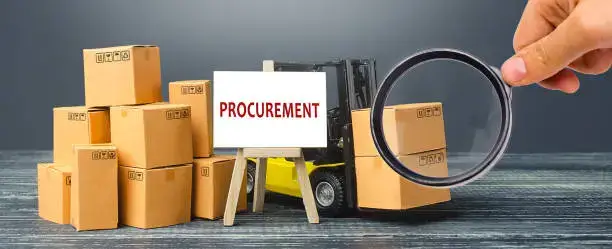
As a business owner or procurement professional, you know just how much a well-crafted procurement plan matters to the success of your supply chain. But with so many moving parts, knowing where to start can be challenging or confusing. That’s why we’ve compiled a list of expert tips to help you develop an effective procurement plan.
Every operation needs a good plan, and procurement is no exception.
Introduction
Procurement is an important process that can make or break your business or supply chain. A well-planned procurement strategy can help you achieve financial goals and reduce operational costs in your supply chain.
However, considering all the factors involved, developing a procurement plan that aligns with your supply chain goals can be tedious. Numerous elements or factors are involved in the procurement process, from identifying suppliers to negotiating contracts.
As a supply chain manager with many years of experience, I understand the importance of developing a procurement strategy that meets your supply chain goals. In this article, I will provide expert tips on developing a procurement plan that aligns with your organization’s objectives and helps you achieve your financial targets.
What is a procurement plan?
A procurement plan is a document that outlines the process of acquiring goods or services from external stakeholders such as suppliers. It includes all the steps in the procurement process, from identifying the need for a particular product to the delivery and payment of the purchased items.
The procurement strategy is essential to any supply chain’s strategy as it sets the framework for the procurement process. A great procurement plan is developed based on your specific needs and requirements.
Your procurement strategy should outline your objectives, the goods or services required, the budget, and the procurement schedule. The plan should also identify all the stakeholders (external and internal) involved in the procurement process and their roles and responsibilities.
Why is a Procurement Plan Important?
A well-crafted procurement scheme is essential for any business or supply chain because it streamlines the procurement process and ensures your organization gets the best value for its money.
A procurement strategy can help with the following:
– Ensuring that the procurement process is efficient and effective.
– Establishing a clear framework for the procurement process.
– Reduce the risk of procurement errors and delays
– Ensure the business gets the most value for its money
– Promote transparency and responsibility in the procurement process
– Ensure compliance with procurement legislation and policies
Key elements of a procurement plan
A good procurement plan should include the following key elements:
# Procurement Objectives
The procurement objectives should clearly define and match your business’s broader aims and objectives. These objectives should be specific, measurable, attainable, relevant, and time-bound. The procurement targets should also be reasonable and based on the budget and resources of the organization.
# Goods or Services Required
The procurement scheme should explicitly specify the items or services requested. The goods or services amount, quality, and specifications are all included. Any particular requirements or standards that the goods or services must meet should also be specified in the procurement plan.
# Budget
The procurement budget should be explicitly stated in the procurement strategy. This comprises the entire acquisition cost, including taxes, tariffs, and shipping charges. The budget should be reasonable and based on the business’s financial resources.
# Procurement Schedule
The procurement strategy should specify the procurement schedule. This comprises the timeframe for each stage of the procurement process, such as the bid or proposal deadline, the assessment period, and the delivery date.
# Stakeholders
The procurement plan should identify the parties involved in the purchase process. This includes the procurement team, end-users of the goods or services, and any other stakeholders involved in the procurement process. Their tasks and responsibilities should also be specified in the procurement plan.
Steps to Creating a Successful Procurement Plan
Creating a successful procurement plan involves the following steps:
# Step 1: Identify the Need
The first stage in developing a procurement strategy is determining the requirement for the specific good or service your supply chain needs. This entails doing a requirements assessment to evaluate the goods or services required to achieve the goals and objectives of the organization.
# Step 2: Establish Procurement Objectives
The procurement objectives should be defined once you have identified the requirement. You must set clear and quantifiable goals connected with your organization’s objectives.
# Step 3: Identify the Required Goods or Services
The needed goods or services, including quantity, quality, and specifications, should be explicitly described. This process involves conducting market research to find possible vendors and their offerings.
# Step 4: Establish a Budget
Your procurement plan should include a budget for the procurement exercise. It should be based on the financial resources of your organization. Estimating the whole cost of the procurement, including any taxes, tariffs, or shipping fees, is required.
# 5: Locate Potential Suppliers
Chose potential suppliers based on their capacity to meet your organization’s needs and their track record of supplying comparable goods or services.
# Step 6: Create a Procurement Schedule
Build the procurement schedule around the timelines for each stage of the procurement process, such as the deadline for submitting bids or proposals, the review period, and the delivery date.
# Step 7: Create your Procurement Plan
The procurement strategy should be built on the important elements discussed before. The procurement objectives, the goods or services required, the budget, the procurement timetable, and the stakeholders engaged are all included.
Best practices for procurement planning
To ensure that your procurement plan delivers real results, it is essential to follow these best practices:
# Involve Key Stakeholders
Include all relevant stakeholders in the procurement process to ensure you properly consider all their needs and requirements.
# Conduct Extensive Market Research
Conduct extensive market research to find possible suppliers and their products and services.
# Establish Specific Procurement Goals
Create specified, measurable, attainable, relevant, and time-bound procurement objectives (SMART).
# Make a Realistic Budget
Create a realistic procurement budget based on the organization’s financial resources.
# Create a detailed procurement schedule.
Create a detailed procurement schedule, including the timetable for each stage of the procurement process.
# Evaluate Bids or Proposals Using Defined Criteria
Evaluate all bids or proposals using the defined criteria to ensure that the selected supplier meets the organization’s needs.
Tools and resources for creating a procurement plan
Several tools and resources are available to help you create a procurement plan. These include:
# Procurement Templates
Procurement templates are guides which can be manipulated to match the needs and specifications of the organization.
# Procurement Software
Procurement software aids you in automating and streamlining the procurement process.
# Procurement Training
Procurement training will assist you and other procurement professionals in developing the necessary skills and knowledge to develop successful programs.
FAQs on Procurement Plan
1. How often should I review or update my procurement plan?
Evaluate and modify your procurement plan regularly throughout the supply chain or organizational lifecycle. Changes in the scope, budget, or supply chain requirements may necessitate changes to the procurement strategy. Periodic reviews also aid in assessing the efficacy of procurement methods, identifying areas for improvement, and incorporating lessons learned.
2. Can I modify my procurement plan during the procurement process?
Yes, if circumstances change, you can update or change your procurement plan during the procurement process. However, modifications should be controlled and transparent. There should also be sufficient documentation and stakeholder involvement. Any changes should be in accordance with procurement standards and ensure fair and equal treatment of suppliers.
3. Can my procurement plan be used for a different supply chain or organization?
While procurement plans for different supply chains or organizations may have similarities, adjusting the plan to each case’s demands and objectives is critical. Project scope, budget, and procurement requirements may all differ, prompting customization of the procurement strategy to ensure its efficacy and applicability.
Conclusion
Developing a well-thought-out procurement plan is critical for any organization to streamline its procurement process, cut costs, and achieve better results. Create a strategy that produces genuine results by following the expert advice in this article.
Remember to involve key stakeholders, perform thorough market research, make clear procurement objectives, design a realistic budget, create a clear procurement timetable, and analyze bids or proposals based on the defined criteria. With these best practices in mind, you can develop a procurement strategy to help your supply chain succeed.

Obinabo Tochukwu Tabansi is a supply chain digital writer (Content writer & Ghostwriter) helping professionals and business owners across Africa learn from real-world supply chain wins and setbacks and apply proven strategies to their own operations. He also crafts social content for logistics and supply chain companies, turning their solutions and insights into engaging posts that drive visibility and trust.








